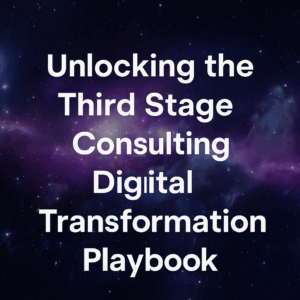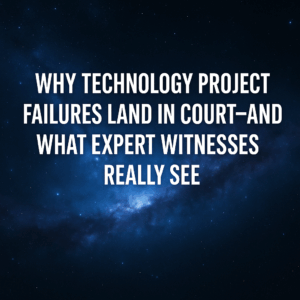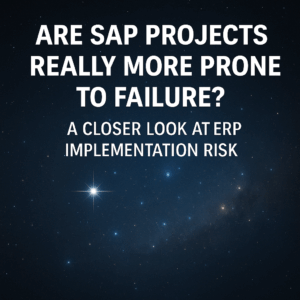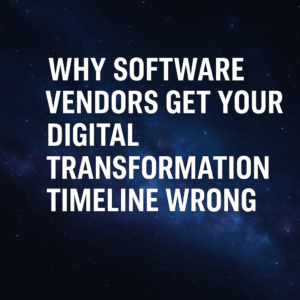Agile is a significant trend in software development and digital transformation deployment. However, it is also gaining popularity in the change management field. Therefore, the question arises: Can agile and change management work well together?

Agile is a significant buzzword in the digital transformation space. Software developers are using agile as a means of developing better software, and even software implementation teams are employing agile to deploy technology faster. Change management teams are also incorporating agile concepts into their strategies and approaches. However, while agile is appealing to organizations, it is not always the best approach for change management initiatives. Therefore, today we want to discuss the pros and cons of agile. We will begin by explaining what agile is and whether it is suitable for your change initiative.
Table of Contents
ToggleWhat is Agile?
To begin, it is helpful to summarize what exactly agile is. To understand agile, it is essential to look back and understand what led us to this path. If we look 10 or 20 years back in the past, we can see that software deployments were becoming big and bloated. They were using a waterfall approach, which is a more sequential approach to developing and deploying software. In that waterfall approach, you would define all of your business requirements upfront, get user sign-off on business requirements, then start designing the software, followed by building and testing it sequentially. While this sounds natural enough, the problem with waterfall development was that it was becoming bloated, taking a long time, and costing a lot of money. It was taking a long time to get to value realization of those solutions.
As often happens in the world of digital transformation and in many other aspects of our lives, the pendulum swung from waterfall to the other extreme, which is agile. Agile was meant to be a response to the fact that waterfall was having some difficulties with value realization. To summarize, agile deployments are more iterative and more rapid. Instead of having a sequential milestone-based, stage-gate-based approach to deploying software, agile focuses on just getting some functionality out there for people to throw darts at, to respond to, and to iteratively pivot and adjust based on feedback from those solutions that are rolled out quickly to the organization.
On one hand, agile has addressed some of the challenges and downsides of the waterfall approach, but on the other hand, it has unintentionally introduced some additional risks and challenges. Therefore, today we want to discuss the things you should consider as it relates to agile when developing your change management strategy and plan.
Organizational Change Impacts
One of the most foundational aspects of a successful change strategy and plan is change impact. Change impact is a way to define how people’s jobs will exactly change as a result of new technological and business process improvements. However, one of the problems with agile in relation to change impact is that agile is meant to quickly roll out software to the organization, even if it’s to a small pilot group or just a small functional area within a larger organization. The whole concept of agile is to deploy software quickly and iteratively adjust and improve that software as it’s being deployed.
The problem with this, as it relates to change management, is that it creates a moving target as we’re trying to define how this technology will impact people’s jobs. If we can’t help people understand effectively how their job will change, we haven’t done our job very well as change management consultants. The tricky part and risk of agile change management approaches as it relates to change impact is that we have to figure out how to define and articulate what the change impacts will be as technology is being deployed. There’s a high risk of us being behind the curve and being too late to identify those change impacts.
Therefore, we need to figure out how to better intertwine and get ahead of these agile deployments so that we’re leading with the people rather than leading with the technology.
Organizational Design
Now, the next challenge with agile deployments, as it relates to change management, is organizational design. Every effective organizational change strategy I’ve been a part of effectively looks at organizational design and defines how jobs are going to be designed, how we’re going to restructure, reorganize roles and responsibilities, somewhat similar to change impact but more focused on individual job roles and responsibilities. Here’s where we define if someone’s going to have x percent of their job automated, what are we going to do with that x percent of that person’s job?
The problem with agile deployments is that the technology is moving so fast that we’re not able to adequately think through those sorts of strategic issues of how we can organize ourselves and what is it we want to be when we grow up organizationally before we roll out the technology. Again, as is the case with change impact that we just discussed, what ends up happening is we come in late to define what the organizational structure may be or what the new organizational design may be after technology has already been rolled out to the organization, which is a problem.
Again, the whole theme here that you’re going to hear as we talk through this is that people and the change management aspect of any digital transformation is typically on the critical path. That’s typically the thing that’s either going to slow down or speed up your deployment depending on how well you do change management. If we’re not doing change management well, that’s going to slow down the overall deployment, even if we’re rolling out technology faster than we might have done in a waterfall type of environment. This is something else we have to think through and address as part of our change strategies in agile-related environments.
Business Alignment
Overall, business and stakeholder alignment is a critical part of an effective organizational change strategy. If we are deploying technology faster than we can define the change impacts, organizational design, and some of the other things I’m still going to talk about in this video, then we haven’t adequately addressed this whole alignment issue to ensure that we’re all aligned and on the same page with what this transformation means to the organization and ultimately what its impact is.
For example, oftentimes there are strategic goals and objectives that an organization wants to accomplish as a result of its digital transformation, and these are very clear strategic goals and objectives that align with the overall goals and objectives of the organization. If we don’t have that sort of alignment, we haven’t worked through what we want to be when we grow up and how we want to accomplish our goals and objectives using this digital transformation, then that’s going to be a problem. It doesn’t matter how good the technology is, or how advanced or sophisticated the technology may be, if it doesn’t align with our overall goals and objectives as an organization, we’ve got misalignment, and we’re losing value on that deployment.
In other words, the money and time we save by deploying technology quickly are quickly canceled out by the fact that we’re not aligned, and we’re not getting business value out of that technology. So, in order to be successful, we have to figure out ways to ensure that we have that alignment and we spend the time upfront to gather and gain that alignment before we start rolling out new technologies to the organization
Process Integration
One of the appealing aspects of agile digital transformations is that we can roll out technology without having to wait to define business processes, requirements, or other activities that can take a lot of time to align internally. However, many organizations, if not most, are undergoing their digital transformation to integrate their end-to-end business processes and achieve better alignment across the enterprise. If we focus solely on quickly deploying technology, we may not take the time upfront to define and refine our business processes as we want them to be.
From a change management perspective, this is problematic because without clarity and alignment on end-to-end business processes, people will not accept or adapt to changes as quickly as they would if we took the time to adjust and ensure that we have addressed what the business process model and target operating model should look like. Therefore, we must not neglect the crucial end-to-end business process flow component of digital transformation by going too far down the path of agile.
Training and Communications
Once we are knee-deep in any sort of digital transformation, one of the core execution tasks within change management is typically training and communication. This is where we communicate the changes, why we are going through the process, and start to train people on the new processes, technologies, and other aspects of change management. Within training and communication, we need pretty good clarity on all the other things we have talked about – the change impacts, organizational design, and what the end-to-end process flows are going to look like. These are all prerequisites to effectively doing training and communication.
As we get further into the digital transformation, if we have not effectively done those things upfront, we will again be behind the curve as a change management team. We will be taking aim at a moving target because technology is being developed and iterated by technical people working directly with end-users. This can become a problem from a change management perspective where we lose a lot of the value that we get from change management from a people, adoption, and business value perspective. Therefore, we need to think about how to integrate and ensure that we get enough clarity and slow down just enough in an agile environment to be sure that we have defined the impacts on the organization and that we are communicating to people what they need to hear and know about their jobs and future state business processes. We also need to train people in a way that ensures they fully understand these technologies before they are rolled out or forced down the organization’s throat.
How To Align Agile with Change Management
So this all begs the question, how do we align change management with agile types of deployments? There are three things I can think of that will really help you as you get started on your agile transformation from a change perspective.
First, recognize that agile versus waterfall, is not necessarily an all-or-nothing proposition. In other words, you’re not choosing agile or waterfall. Typically, you’re choosing something in between, or at least you should be choosing something in between. You don’t necessarily want either extreme. So the idea here is to figure out where you actually want to fall on the continuum of agile versus waterfall. It may be that you lean pretty heavily towards agile, but it doesn’t necessarily mean that you’re going all-in on the agile approach, in the same way a software development company would. In a digital transformation, there are things you have to do to make sure your organization is aligned, and so in that case, you may want to back off a little bit from that whole agile extreme that I’ve talked about so far in this article.
Second, make sure that you don’t lose sight of your overall corporate goals and objectives. And if you and your team don’t fully understand what the corporate goals and objectives are and how this digital transformation aligns with them, then you want to make sure that you take the time to do that before you start designing, building, and deploying new technologies.
Finally, it’s important to recognize and remember that sometimes you can slow down in order to speed up later. In other words, it may be that you do take the time to map out your end-to-end business processes. I know that’s so anti-agile, and it’s more of a waterfall type of mentality, but sometimes you need that. Sometimes you need to take that time to get that alignment. And then certainly, when it comes time to deploy technology after you have that alignment, you can take all the agile approaches you want, and you’re actually going to be able to be more agile and more effective in your agile deployments because you have that clarity up front.
So, it goes back to the first point. If it’s not an all-or-nothing proposition, you can pick and choose bits and pieces of waterfall, bits and pieces of agile to create the digital transformation strategy and plan that makes the most sense for your organization. What I will say is that the bigger the change that you envision for this transformation, in other words, if you’re making a quantum leap from an old mainframe legacy system, now you’re going to go to a fully baked cloud or SaaS system, that’s a big jump. And companies that are taking a big leap like that in their transformations are more likely to need to take more time upfront to define what those processes are going to be, what the impact of the organization is, and what the overall change strategy is.
If you’re used to change and you’ve been through a lot of deployments in the past, and you’re taking more of an incremental approach to your transformation, maybe you lean a little bit more heavily towards agile. You may not completely throw out everything that relates to waterfall, but you may take more of an agile approach. So those are just a few things to think about, a few ways to think about how you can coexist in the world of change management along with agile environments.
If you are looking to strategize an upcoming transformation or are looking at selecting an ERP system, we would love to give you some insights. Please contact me for more information eric.kimberling@thirdstage-consulting.com





